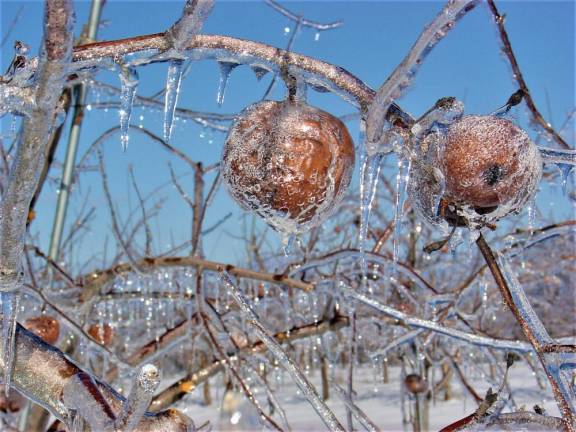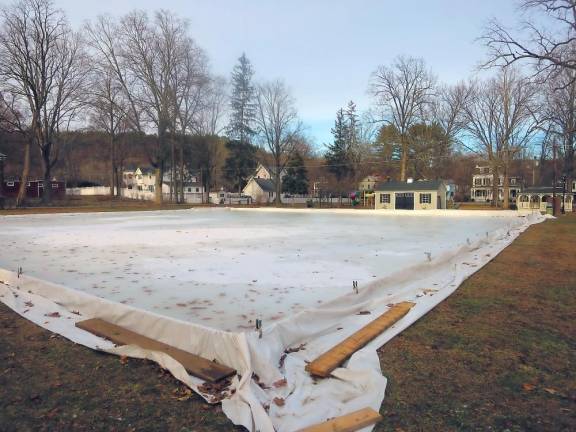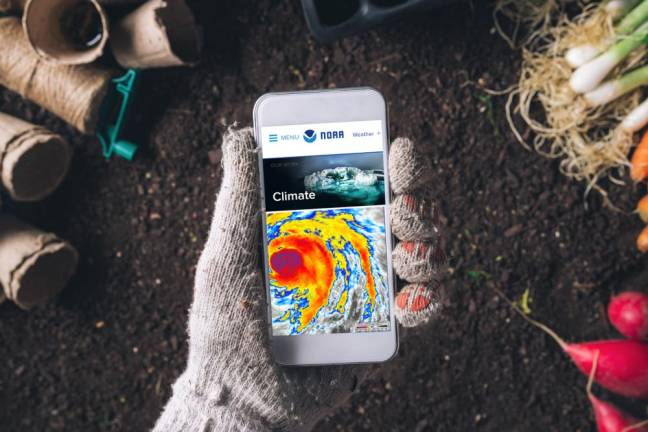Local voices on climate change: 'You cannot deny it'
Environment. As every winter seems to melt away earlier than the one before, Straus News talked with people who depend on the weather about what they’re seeing as the climate changes.



If you don't believe in climate change, ask the farmer who never saw his father lose a crop to hail but has lost his own crop this way, year after year.
If you don't believe in climate change, ask the growers who have watched too many of their apples nipped in the bud.
If you don't believe in climate change, ask the organizer who declares his professional ice show a thing of the past.
“I tell people, ‘If you do not believe in climate problems happening in the world today, become an outdoor producer of ice shows," said Mike Carson, creator of the Milford, Pa., Winter Lights Festival. "You’ll find out immediately why there is a problem. Folks, it’s in front of your eyes! You cannot deny it.”
Once upon a time, when winter was still properly cold, an ice show with professional skaters performing an original piece was the focus of the festival, Carson said.
Volunteers would build an outdoor ice rink for the event that both the public and the pros would use. The ice skating was free.
“You spread water, and you wait until it freezes, and build and build and build, so, if it melts, it only melts one level,” Carson said. “Unless there is a climate problem, and then you have a swimming pool.”
But as freezing temperatures increasingly gave way to milder weather, continuing the ice show and skating, as well as the ice sculpting of previous events, was no longer an option.
The professional skaters couldn’t skate on melting ice. "This is their livelihood,” Carson said. “If they slip, or their skate gets caught in a crevice or something, it could be the end of their career.”
Ideas were floated to keep the show and skating going, like looking for an indoor ice rink, or using artificial ice. Ultimately, they were not successful.
“You can argue about the president, you can argue about anything else you want, but this is happening, and it’s going to affect you directly,” Carson said. “And when it does, it doesn’t go back.”
In the absence of the ice activities, the mac and cheese and chili contest has become much more central to the event, Carson said. The contest pits home cooks against professional chefs and features gluten-free and vegan options.
Hard hit on the farm
As a fourth-generation onion farmer, Chris Pawelski of Goshen, N.Y., said every day is an exercise in unpredictability. Pawelski grew up on the farm, and has definitely seen a change in weather patterns over the years.
“I was hit by hail and wiped out in 1996," he said. "I was hit by hail and wiped out in 1998, and I was hit by hail a couple other times in the late ‘90s, early 2000s. My dad’s cousin, who owned the land for 40 years prior to that, was not hit once, ever. Something is seriously wrong.”
It used to be that gradual springs and falls would make way for summer, with the occasional bad storm, and appropriately long winters.
“Now it seems, quite often, like you’re going right from winter into a short spring and right into summer – with a lot of early heat,” Pawelski said. “A couple times my onions, just coming out of the ground, were wiped out by early heat waves. I don’t think that ever happened to my father.”
The biggest threat, though, is hail.
“Every summer you’re on pins and needles during the growing season,” Pawelski said. “There’s a constant threat of hail storms and severe weather. Maybe I was more interested in Bugs Bunny (as a kid) and wasn’t paying attention, but I don’t remember it being like it is now.”
To stay informed and make sound business decisions, Pawelski said he relies on 30 different weather apps on his phone, including two that he subscribes to, as well information from the National Oceanic and Atmospheric Administration.
In an industry that is largely at the mercy of the weather, unpredictability can lead to devastating crop losses.
“I know what the weather was like when I was a kid, and it was very different,” he said. “I know what the seasons were like, and it’s very different.”
Winter carnival moves indoors
Jeanne Montemarano, the parks and recreation director for Sparta, N.J., said the township’s annual winter carnival has changed over the years, from a mostly outdoor event to one held primarily indoors. She thinks the reason is twofold.
“We were hardier back in the ‘80s,” she said. “It could be cold enough, even if we didn’t have snow. But people don’t want to be standing outside running activities in the cold.”
When the event first began, it was held outdoors, Montemarano said. But even then, it was difficult to predict if the weather would cooperate.
“You could never tell if it was going to be warm,” she said. “And then, some winters, they had to cancel because there was too much winter.”
Montemarano said it also comes down to liability.
“Insurance companies don’t like outdoor ice skating on ponds and open waters,” she said. “Back in the ‘60s and ‘70s we outdoor ice-skated all the time, but most people don’t do it anymore. Part of that is a function of the ice isn’t freezing, and insurance companies and lawyers have made it too scary to even try.”
The apples wake up early
Though farming has never been an easy way to make a living, the Pennings family of Warwick, N.Y., said the changing climate has affected both the growth and the sale of apples, making it that much harder.
“You get these snowstorms in March, which makes winter feel like it goes on forever, when really it never got here until December or January,” Steve Pennings Sr. said. “So it feels like there’s a little shift in the seasons.”
That shift means that, these days, the apple trees are waking up earlier than before, starting the growing season sooner.
An earlier growing season comes with increased risk, SJ Pennings said.
“If you have a week or two when it’s 60, 70 degrees in February, and the trees break dormancy, those first buds that come out are the flowers, and then you’re in trouble,” he said. “You know it’s going to get cold again, and that’s going to kill your crop completely.”
Unlike with other types of crops, SJ said apple growers can’t change their planting schedule to work around temperature fluctuations.
“Those trees are out there, and they’re not going to wait,” he said. “They decide when they’re going to open.”
When a storm does take out the crop, the public generally doesn’t realize what that means, said Tori Pennings Cosimano.
“It’s very hard for people to understand why there’s no apples on the trees because that (weather) event happened six, seven months ago, and they don’t remember it,” she said. “They ask, ‘How are you out of apples?’”
If the crop manages to survive, the changing climate and earlier harvest time is causing people to rethink the way they pick apples.
“(People) used to wait until you got that first night of frost, and you’re into September,” Steve Sr. said. “Now they’re coming out in shorts and tee shirts for apple picking. It used to be a fall thing, when they’d get out there in dungarees and work boots.”
Cosimano is a 10th grade science teacher in the Warwick Valley School District. She said none of the weather events they’ve seen on the farm are out of the realm – it’s just the frequency at which they’re happening.
“It’s more extreme and drastic,” SJ said. “That’s what causes trouble.”